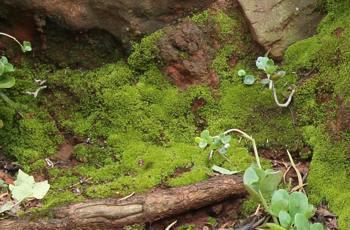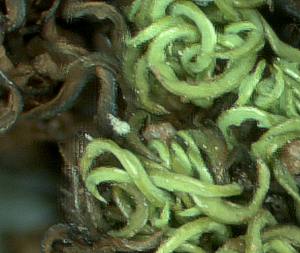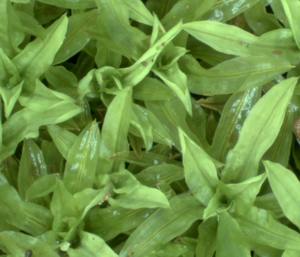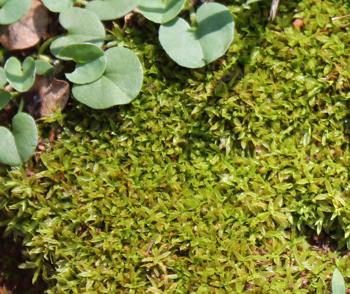Trichostomum brachydontium
Trichostomum brachydontium Bruch
Family: Pottiaceae
Common names: Variable crisp-moss
Introduction
Trichostomum brachydontium is the most widespread and frequently collected moss in South Africa.

Description
Description
The plants form tufted, yellow-green to dark green sods or cushions (sometimes extensive) on soil. The stem has a central strand of differentiated cells and grows 4-26mm tall. The leaves are tightly incurled (crisped) when dry, but widely spreading when wet, giving the plant a completely different appearance.

The tongue-shaped leaves are 2.5-3.5mm long with plane, entire margins, and a short protruding midrib. The cells of the upper leaf blade are thick-walled and covered in numerous papillae, while the basal cells are thin-walled and smooth.

Plants are rarely fruiting (with sporophytes) in South Africa. The yellowish stalk that bears the erect, short-cylindrical capsule is 5-10mm long. The peristome teeth at the mouth of the capsule are rudimentary or absent.
Conservation Status
Status
Trichostomum brachydontium is widespread, common and frequently collected in South Africa, therefore not threatened.
Distribution and habitat
Distribution description
Trichostomum brachydontium is almost cosmopolitan in distribution, absent only from Antarctica. The species occurs in Namibia, Botswana, Swaziland, Lesotho and all nine provinces of South Africa.
In South Africa, Trichostomum brachydontium grows in a large variety of habitats, but is usually found on damp soil or soil over rock on southern aspects of exposed sites or in semi-shade. It is most frequently encountered in the eastern and central parts of the country.
Derivation of name and historical aspects
History
The name Trichostomum is derived from trichos (hairy, hair-like) + stoma (mouth), alluding to the filiform or hair-like peristome teeth at the mouth of the capsule. The English name 'variable crisp-moss' refers to the variable nature of the species and the leaves that are crisped (tightly incurled) when dry. Trichostomum brachydontium is also known as the 'common hairy-mouth moss'.
Trichostomum ( sensu lato ) consists of about 105 species worldwide, of which 19 are known from Africa and three are currently accepted for South Africa. Trichostomum brachydontium is recognized by its habit, presence of a central strand in the stem, broad, tongue-shaped leaves with a short protruding midrib, and the peristome absent or rudimentary.

Ecology
Ecology
This frequently collected and widespread moss belongs to the family Pottiaceae, a large group of mosses adapted to withstand desiccation in harsh environments. The growth form and tightly incurled (crisped) leaves of Trichostomum brachydontium decrease water loss during hot and dry conditions. It is fascinating to watch (use a hand lens or dissecting microscope) how quickly dried plants absorb water and the leaves unfold.
Uses
Use
Trichostomum brachydontium is frequently found in gardens (e.g. in the Pretoria National Botanical Garden), usually on bare, sandy soil where nothing else will grow. Here the attractive yellow-green carpets or cushions formed by this moss add to the biodiversity and beauty of the surroundings and prevent soil erosion. It is not a weed and should be left undisturbed.

Growing Trichostomum brachydontium
Grow
This moss is not known to be cultivated in South Africa or elsewhere, but this can be tried by following advice on the internet, e.g. the MountainMoss website.
References
- Atherton, I., Bosanquet, S. & Lawley, M. (eds). 2010. Mosses and Liverworts of Britain and Ireland - a field guide. British Bryological Society.
- Glime, J.M. 2007. Bryophyte Ecology . Volume 1. Physiological Ecology. Ebook sponsored by Michigan Technological University and the International Association of Bryologists. Accessed on 29 Novembert 2013 at <http://www.bryoecol.mtu.edu/>
- Magill, R.E. 1981. Flora of Southern Africa . Bryophyta. Part 1 Mosses. Fasc. 1 Sphagnaceae-Grimmiaceae. Botanical Research Institute, Pretoria.
- Mountain Moss. Experts in moss landscaping and design. Accessed on 28 November 2013 at < http://mountainmoss.com >
- Van Rooy, J. 2001. Introduction to bryology in southern Africa. 10. Eleven mosses to know. PlantLife 25: 37-40.
- Zander, R.H. 1993. Genera of the Pottiaceae: mosses of harsh environments. Bulletin of the Buffalo Society of Natural Sciences 32: 1-378.
Credits
Jacques van Rooy
National Herbarium / Biosystematics Research & Biodiversity Collections
December 2013
Plant Attributes:
Plant Type: Moss
SA Distribution: Eastern Cape, Free State, Gauteng, KwaZulu-Natal, Limpopo, Mpumalanga, North West, Northern Cape, Western Cape
Soil type: Sandy
Flowering season:
PH:
Flower colour:
Aspect: Shade, Morning Sun (Semi Shade)
Gardening skill: Challenging
Special Features:
Horticultural zones











Rate this article
Article well written and informative
Rate this plant
Is this an interesting plant?
Login to add your Comment
Back to topNot registered yet? Click here to register.